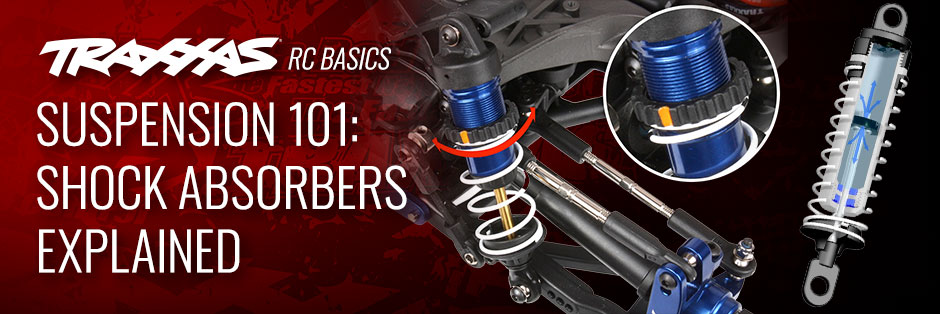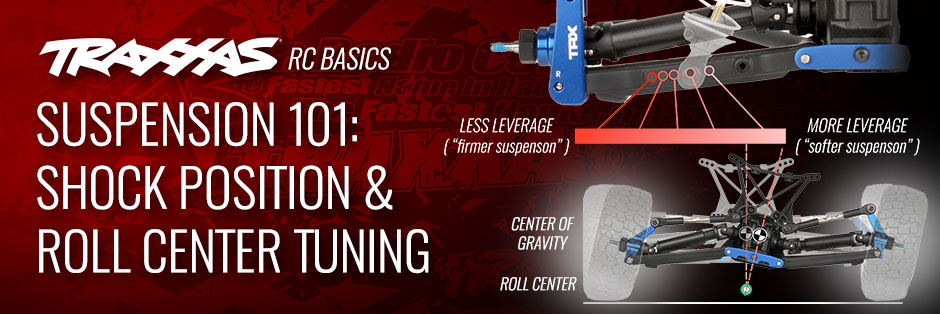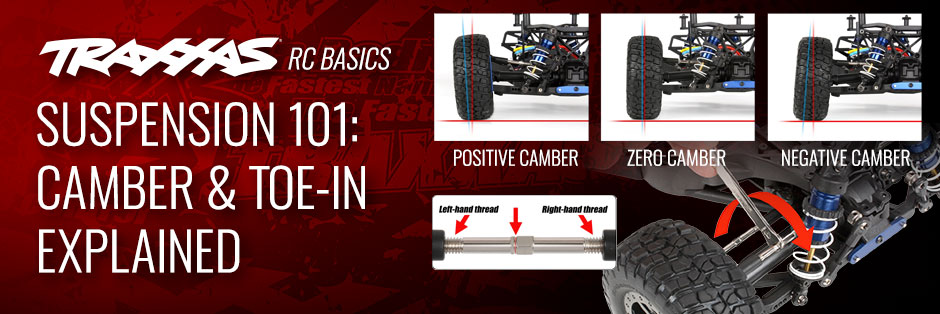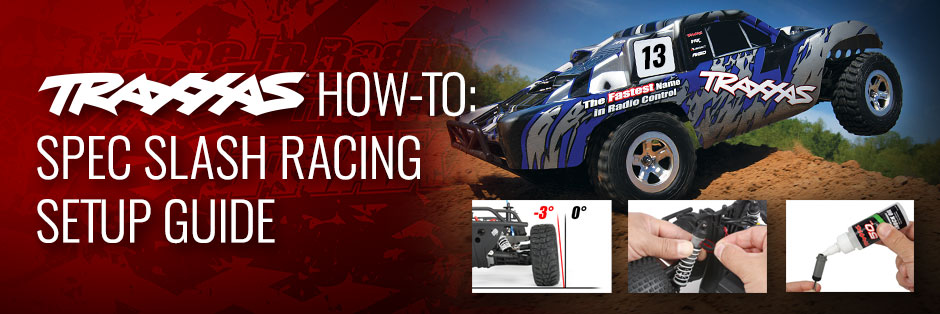Learn How to Tune Your Slash for Race-Winning Results

The “spec” in spec racing stands for specifications, meaning each car must be built and equipped to a certain set of specifications (specs) to be race-legal. Of course, all types of race classes have specs the cars must stay within, but in spec racing, the rules are especially limiting. This keeps the racing close, reduces costs, and puts the focus on driving skill. Spec Slash rules typically require the trucks to be run completely stock, and allow tuning changes to be made only with the settings available—no cutting, drilling, or other modifications allowed. Spec Slash rules often include this important maxim: “If the rules don’t say it IS allowed, then it ISN’T allowed.” In Spec Slash, you get to the winner’s circle the same way you get to Carnegie Hall—practice, practice, practice!

Shocks
The Slash arrives with 30wt oil in the shocks, which delivers relatively light damping for a very active suspension that respond quickly to bumps. Since most tracks have carefully prepared surfaces that are relatively smooth (or very smooth, or even carpeted), the shocks can be filled with higher-viscosity (thicker) oil to increase damping. This will reduce chassis roll when cornering, reduce squatting and diving under acceleration and braking, and help prevent bottoming-out on jump landings—all of which will improve handling precision and help your Slash feel more “planted” and in-control.
Watch out for shock “packing.” If a bumpy track requires the shocks to extend and compress more quickly than the heavier damping will allow, the shocks will “pack up” and only operate in a narrow portion of their total available travel, leading to reduced traction and control, and a rougher ride. If you experience packing, refill the shocks with lower viscosity oil.
 The 5038X shock oil set with carousel rack is an indispensable accessory for Slash suspension tuning.
The 5038X shock oil set with carousel rack is an indispensable accessory for Slash suspension tuning. For detailed shock-filling instructions, watch this Traxxas Support video.
For detailed shock-filling instructions, watch this Traxxas Support video. For a detailed look at how shock absorbers work, consult Part 2 of the RC Basics Suspension Tuning Guide.
For a detailed look at how shock absorbers work, consult Part 2 of the RC Basics Suspension Tuning Guide.Spring Preload / Ride Height
- Set ride height with the battery installed, and give the chassis a bounce or two to make sure the truck is settled on the suspension when checking your settings.
- Ride height will change with battery weight (a heavy battery will lower ride height, a lighter battery will raise it). FYI if your batteries aren’t identical.
- It’s common to set front ride height 1-3 mm lower than the rear ride height. This helps improve steering response, and counteracts the tendency for the chassis to lean back and shift weight rearward under acceleration.
 The Slash includes preload spacers in four thicknesses.
The Slash includes preload spacers in four thicknesses. Install spacers above the springs to increase ride height.
Install spacers above the springs to increase ride height. The Slash includes preload spacers in four thicknesses.
The Slash includes preload spacers in four thicknesses.Shock Position
- 1) The amount of leverage the arms apply to the shocks when the wheels hit bumps and lands off of jumps.
- 2) The maximum distance the suspension arms can swing away from the chassis (known as “down travel”).
Recommended Setting: Factory settings, which are innermost mounting hole (front); second hole from inside (rear).
Tuning Notes: The three inside holes on the rear suspension arms will suit the vast majority of tracks. The two outermost holes will only be appropriate for tracks with very smooth, high-grip surfaces and mild jumps.
 The rear arms’ three inside holes will suit the vast majority of track conditions.
The rear arms’ three inside holes will suit the vast majority of track conditions. For a detailed look at how shock position affects handling, consult Part 3 of the RC Basics Suspension Tuning Guide.
For a detailed look at how shock position affects handling, consult Part 3 of the RC Basics Suspension Tuning Guide.Wheel Alignment: Toe and Camber
Toe-in and camber refer to the angles of the wheels relative to the chassis. “Toe” is the angle of the wheels relative to the chassis centerline, as viewed from above. Camber is the angle of the wheels relative to vertical, as viewed head-on. Only front toe is adjustable on the Slash, rear toe is fixed. Camber is adjustable for all four wheels, and both camber and toe are set via the turnbuckle suspension links (an adjustment wrench is included with the truck). Front toe is usually set between 1° toe-out (the wheels’ leading edges point out) and 1-2° toe-in (the leading edges point in). Camber settings are usually between 0° (wheels perfectly vertical) and negative 1-3° (the wheels lean toward the chassis). Positive camber angles would lean the tires away from the chassis, severely reducing grip, and are not used.
Recommended Camber Settings: -2° (front); -2.5° (rear)
Front toe is a very useful setting for altering steering feel. Increasing toe-in will generally improve straight-line stability and make turn-in less aggressive. Reducing toe-in has the opposite effect. Toe-out settings deliver very responsive steering at the expense of stability.
When cornering, the wheels on the outside of the turn tend to lean away from the chassis, reducing their footprint and traction. Negative camber angles counteract this. Alter your camber angles 0.5 or 1° at a time and test until you’re happy with cornering grip and feel.
 Camber is typically set between -1 and -3°. Positive camber angles aren’t used.
Camber is typically set between -1 and -3°. Positive camber angles aren’t used. A gauge makes it easy to set camber angle precisely. Click here for a full-size image of the gauge shown. Just print it out and mount it to stiff card.
A gauge makes it easy to set camber angle precisely. Click here for a full-size image of the gauge shown. Just print it out and mount it to stiff card.  Most drivers don’t actually measure toe angle, they just eyeball it. Adjust each steering tie rod in equal increments when making toe changes.
Most drivers don’t actually measure toe angle, they just eyeball it. Adjust each steering tie rod in equal increments when making toe changes. For a detailed look at how camber and toe-in affect handling, consult Part 1 of the RC Basics Suspension Tuning Guide.
For a detailed look at how camber and toe-in affect handling, consult Part 1 of the RC Basics Suspension Tuning Guide.Rear Roll Center
The Slash offers two positions for the camber links on the rear shock tower. Changing the link position will alter the rear roll center (this is the virtual point around which the chassis will rotate, formed by the geometry of the suspension arms and camber links). Part 3 of the RC Basics Suspension Tuning Guide takes a deep dive into roll center, but here’s the nutshell: moving the camber link to the upper position on the shock tower will lower the truck’s roll center relative to its center of gravity. This will cause more weight transfer to the outside wheels while cornering, and can improve grip in loose conditions.
Moving the camber links to the upper positions will also alter the wheels’ camber angles, so be sure to readjust your settings. You’ll also need to shave some material from the shock tower to permit full suspension travel when using the upper positions.
 The lower link position is the factory setting. The upper hole will lower the Slash’s roll center.
The lower link position is the factory setting. The upper hole will lower the Slash’s roll center. For a detailed look at roll center, consult Part 3 of the RC Basics Suspension Tuning Guide.
For a detailed look at roll center, consult Part 3 of the RC Basics Suspension Tuning Guide.Gearing
Consult your track’s Slash Spec rules to see if gearing changes are permitted. If they are, most tracks will specify which pinion and spur gear combinations are allowed. For example, you may be allowed to choose a 16-tooth pinion and 90-tooth spur gear, or 17 and 86-tooth gears. Dividing the spur gear tooth count by the pinion gears gives us the ratio for each gearing combination (which we’ll round to the second decimal):
90 � 16 = 5.63
86 � 17 = 5.06
 The Slash’s stock 16/90 gearing delivers a 5.63:1 ratio
The Slash’s stock 16/90 gearing delivers a 5.63:1 ratioDifferential
The Slash is equipped with a planetary-gear differential that is not designed to hold silicone oil, but if your track’s rules permit it, you can still use silicone oil to tune differential action. As assembled from the factory with greased gears, the diff action is very free and will easily transfer power to the wheel with the least traction (this is known as “diffing out”) which can upset cornering and power delivery, especially on loose tracks. To tighten up diff action, clean the grease out of the differential housing and off the gears, then reassemble the parts and fill the differential halfway with 100K silicone oil. The thick oil will not leak out of the diff quickly, and can greatly improve loose-track handling.
 Clean the grease from the differential gears before filling with silicone oil.
Clean the grease from the differential gears before filling with silicone oil.Body
Short-course bodies are prone to “parachuting” when jumping. The body captures air, which slows the truck and often causes it to land on the rear bumper—not the fast way around the track. If the rules permit it, you can vent the body to allow air to pass through more easily. The Traxxas body reamer (3433, 3433X) is the ideal tool for this. Use the reamer to make holes on the fenders, hood, and rear deck. Large holes and/or too many of them will weaken the body, so keep them under 10 mm and don’t overdo it.
 The 3433 body reamer is a must for making perfect holes in polycarbonate bodies.
The 3433 body reamer is a must for making perfect holes in polycarbonate bodies. The fender tops catch a lot of air. Avoid venting close to the body mounting holes.
The fender tops catch a lot of air. Avoid venting close to the body mounting holes.Tires
Track rules may permit you to use different styles of Traxxas tires, and you’ll likely notice the fastest drivers are all on the same tires. Even if your Slash is already on the preferred rubber, it pays to get an extra set of tires to use reserve for race use while you burn up the original tires with street driving and all-around off-roading the rest of the week. When your race tires begin to round the sharp edges off of their lugs, swap the wheels left to right so the trailing edges (which should be sharper) are now the leading edges and will offer more bite. Note that the Slash’s front and rear rims have different offsets, and should not be swapped. Front wheels will fit onto the rear axles just fine and vice-versa, but the truck will have an extra-narrow front end and an extra-wide rear end—not the hot setup.
 Replica Kumho (left) and BFGoodrich tires outfit the current Titan-powered Slash models.
Replica Kumho (left) and BFGoodrich tires outfit the current Titan-powered Slash models.Show Us Your Spec Slash
Are you racing Spec Slash? We want to see your truck, hear about your setup, and check out the action. Be sure to tag Traxxas and include #SpecSlash when you share pics, posts and videos from the track or at your bench. Good luck, and have fun!


 Canadian Dollar (CAD)
Canadian Dollar (CAD)
 Euro (EUR)
Euro (EUR)
